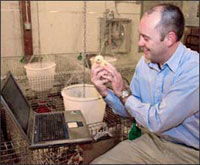



Federal Grant Furthers Chicken Genome Work
US - Chickens are often used in place of humans in jokes and cartoons, and science has found they are helpful models for genetic research as well.Dr. Shane Burgess, a Basic Sciences associate professor in Mississippi State University’s College of Veterinary Medicine, along with colleagues Drs. Fiona McCarthy and Susan Bridges, received a $1.4 million grant in 2008 from the National Institutes of Health to continue his work annotating the chicken genome. McCarthy is a CVM Basic Sciences assistant research professor, and Bridges is an MSU computer science professor and CVM adjunct professor.

“This grant is particularly impressive because to receive NIH funding, one must demonstrate that the project has a direct relationship to human health,” CVM Dean Kent Hoblet said.
Burgess said the chicken genome was sequenced in 2004 at a cost of $30 million. Scientists identified all 1.3 billion letters of the genetic code in small chunks of 800 letters. Massive computers were used to put these tiny bits of genetic information into a useable form.
“Imagine taking a big book like the Bible, then breaking it into chunks of 800 letters, scrambling them, and then trying to put it back together without having a model to follow,” Burgess said. “That is what we’re trying to do with genomes. The computers that we use to do this are limited by our knowledge -- and that is quite limited.”
The first part of the work involved improving what is known about the chicken genome, correcting some mistakes made in the original annotation and identifying new genes that may have been missed the first time.
“In doing so, we have already been able to use our data from the chicken to fix problems in the human genome and identify new human genes,” Burgess said. “The next thing we’re going to do is assign standardized gene names to all 25,000 genes in the chicken genome that match the equivalent name in the human. This makes it easier to compare genes from the chicken with genes from other species, and thus to use the chicken as a better animal to help us solve human health problems.”
The NIH grant is also being used to do another kind of annotation.
“We’ll take all the functional information that has ever been published about any of the genes and assign it to each of these old genes, and the new genes we find, using a specific ontology, or a very well-defined dictionary,” Burgess said. “The first part of the work was creating the dictionary of the genome. The second part will go on top of this and be more like an encyclopedia. We will make all this data publicly available to all the geneticists in the world.”
The value of a genome sequence entirely depends on the quality and accessibility of its annotation, and on having approved symbols for each gene. Organisms can be compared only if it is clear which genes and proteins are shared between the research species and humans.
“Having approved symbols and gene names greatly improves data mining and allows researchers to exploit the full potential of the chicken genome for comparative and functional genomic studies,” Burgess said. “We will, for the first time, have a computer-friendly encyclopedia of gene functions, and so our computers will have something to work with to help us in our massive-scale genomics experiments.”
This work with the chicken genome has important implications to many other kinds of genetic research. The chicken embryo is highly accessible in eggs, easy to manipulate, and robust.
“After mice, the chicken is the most used biomedical research model for understanding developmental disease,” Burgess said. “It is the most cited non-mammalian vertebrate model organism in all biomedical research, and is an invaluable model for cancer biology, immunology, eye development, head and cranio-facial defects, limb development, and abnormalities such as spina bifida.
“In addition to its biomedical utility, chickens are also the most eaten animal in the world. Bringing in more than $2.3 billion in revenue, chickens are by far the biggest single agricultural crop for Mississippi, more than twice as big as the next biggest, which is forestry,” Burgess said.
MSU has been involved in the annotation of genes of all agricultural animals and many plant crops for 5 years and is recognized internationally as the go-to place for experimental and functional annotation of all agricultural animal genomes on the planet.











